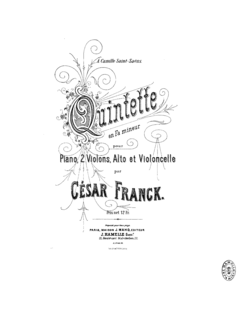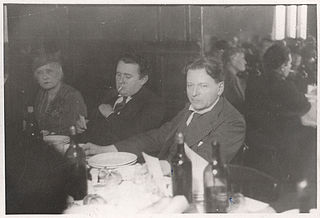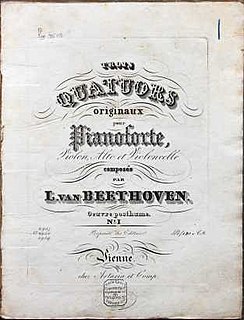Related Research Articles

Chamber music is a form of classical music that is composed for a small group of instruments—traditionally a group that could fit in a palace chamber or a large room. Most broadly, it includes any art music that is performed by a small number of performers, with one performer to a part. However, by convention, it usually does not include solo instrument performances.

In classical music, a piano quintet is a work of chamber music written for piano and four other instruments, most commonly a string quartet. The term also refers to the group of musicians that plays a piano quintet. The genre particularly flourished during the nineteenth century.

A string trio is a group of three string instruments or a piece written for such a group. The term is generally used with reference to works of chamber music from the Classical period to the present. From at least the 19th century on, the term "string trio" with otherwise unspecified instrumentation normally refers to the combination violin, viola and cello. This is how the term is used by major catalogs, including IMSLP.

The Piano Quintet in E-flat major, Op. 44, by Robert Schumann was composed in 1842 and received its first public performance the following year. Noted for its "extroverted, exuberant" character, Schumann's piano quintet is considered one of his finest compositions and a major work of nineteenth-century chamber music. Composed for piano and string quartet, the work revolutionized the instrumentation and musical character of the piano quintet and established it as a quintessentially Romantic genre.
A piano quartet is a chamber music composition for piano and three other instruments, or a musical ensemble comprising such instruments. Those other instruments are usually a string trio consisting of a violin, viola and cello.
The Piano Quintet in F minor, Op. 34, by Johannes Brahms was completed during the summer of 1864 and published in 1865. It was dedicated to Her Royal Highness Princess Anna of Hesse. Like most piano quintets composed after Robert Schumann's Piano Quintet (1842), it is written for piano and string quartet.

Franz Schubert's final chamber work, the String Quintet in C major is sometimes called the "Cello Quintet" because it is scored for a standard string quartet plus an extra cello instead of the extra viola which is more usual in conventional string quintets. It was composed in 1828 and completed just two months before the composer's death. The first public performance of the piece did not occur until 1850, and publication occurred three years later in 1853. Schubert's only full-fledged string quintet, it has been praised as "sublime" or "extraordinary" and as possessing "bottomless pathos," and is generally regarded as Schubert's finest chamber work as well as one of the greatest compositions in all chamber music.
Antonín Dvořák's Piano Quintet No. 2 in A major, Op. 81, B. 155, is a quintet for piano, 2 violins, viola, and cello. It was composed between August 18 and October 8, 1887, and was premiered in Prague on January 6, 1888. The quintet is acknowledged as one of the masterpieces in the form, along with those of Schumann, Brahms and Shostakovich.

Mozart's Piano Quartet No. 1 in G minor, K. 478, is considered the first major piece composed for piano quartet in the chamber music repertoire. The piece is scored for violin, viola, cello, and piano.

The Piano Quartet No. 1 in G minor, Op. 25, was composed by Johannes Brahms between 1856 and 1861. It was premiered in 1861 in Hamburg, with Clara Schumann at the piano. It was also played in Vienna on 16 November 1862, with Brahms himself at the piano supported by members of the Hellmesberger Quartet. Like most piano quartets, it is scored for piano, violin, viola and cello.
Cecil Aronowitz was a British viola player, a founding member of the Melos Ensemble, a leading chamber musician and an influential teacher at the Royal College of Music and the Royal Northern College of Music.
Terence Weil was a British cellist, principal cellist of the English Chamber Orchestra, a founding member of the Melos Ensemble, a leading chamber musician and an influential teacher at the Royal Northern College of Music. He is most known for correcting mispronunciations of his last name, which is commonly mispronounced as "wheel."
String Quartet No. 2 by Walter Piston is a chamber-music work composed in 1935.
String Quartet No. 4 by Walter Piston is a chamber-music work composed in 1951.

César Franck's Piano Quintet in F minor is a quintet for piano, 2 violins, viola, and cello. The work was composed in 1879 and has been described as one of Franck's chief achievements alongside his other late works such as Symphony in D minor, the Symphonic Variations, the String Quartet, and the Violin Sonata.
Six sonatas for various instruments, composed by Claude Debussy, French musician was a projected cycle of sonatas that was interrupted by the composer's death in 1918, after he had composed only half of the projected sonatas. He left behind his sonatas for cello and piano (1915), flute, viola and harp (1915), and violin and piano (1916–1917).

Piano Quartet No. 2 in D minor, Op. 30, is a chamber-music composition by the Romanian composer George Enescu, written in 1943–44.
The Piano Quintet in C major, Op. 18, by Henrique Oswald was finished in 1895. Like most of the piano quintets after the Schumann's, it is scored for piano, 2 violins, viola and cello. A typical performance takes 27–31 minutes.
The Piano Quartet No. 2 in G major, Op. 26 by Henrique Oswald was composed in the second half of 1898. It is scored for piano, violin, viola and cello. The approximate duration is 25–30 minutes.

The Piano Quartets, WoO 36, by Ludwig van Beethoven are a set of three piano quartets, completed in 1785 when the composer was aged 15. They are scored for piano, violin, viola and cello. He composed a quartet in C major, another in E-flat major, and a third in D major. They were first published posthumously in 1828, however numbered in a different order: Piano Quartet No. 1 in E-flat major, Piano Quartet No. 2 in D major, and Piano Quartet No. 3 in C major.
References
- 1 2 3 Walter Simmons (1 February 2004). Voices in the Wilderness: Six American Neo-Romantic Composers. Scarecrow Press. pp. 68–. ISBN 978-0-8108-4884-9 . Retrieved 23 November 2012.
- ↑ Basil Smallman (14 November 1996). The Piano Quartet and Quintet: Style, Structure, and Scoring. Oxford University Press. p. 127. ISBN 978-0-19-816640-5 . Retrieved 23 November 2012.
- ↑ "Bloch: Piano quintets 1 & 2/Kocian". classicstoday.com. Retrieved November 2012.Check date values in:
|accessdate=(help) - ↑ Smallman, Basil (1996). The Piano Quartet and Quintet: Style, Structure, and Scoring. Clarendon Press. p. 153. ISBN 0198166400.
- ↑ Murray, Lucy Miller (2015). Chamber Music: An Extensive Guide for Listeners. Rowman & Littlefield. p. 80. ISBN 1442243430.
- ↑ Pro Arte Quartet -PDF